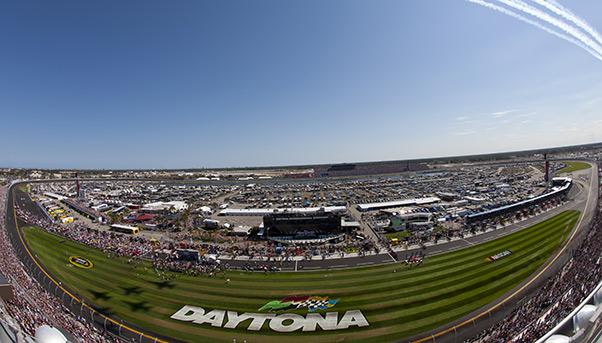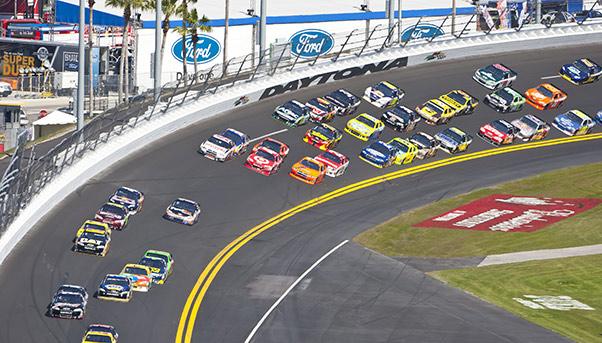
When it comes to road work, there is paving – and then there is paving.
It is one thing to pave a flat, anonymous stretch of highway, and quite another to redo the surface of a revered race track with distinctive curves like the Daytona International Speedway, the “World Center of Racing”.
Built in 1958 at Daytona Beach, Florida, the high-banked, 2.5-mile track is home to the Daytona 500, the premier event of the National Association for Stock Car Auto Racing (NASCAR) that opens the racing season every year.
A veritable temple to NASCAR fans, it is steeped in popular culture, having served as the backdrop for the popular film “Days of Thunder” starring Tom Cruise in 1990, as well as hosted three U.S. presidential visits during NASCAR events.
So it should come as no surprise if anyone in the paving business feels a little intimidated by the idea of having to work on this track of tracks.
«This is no commonplace racetrack», reads “The Daytona Project”, a book published by The Lane Construction Corporation, the U.S. subsidiary of Salini Impregilo, about its experience taking on the challenge eight years ago. «Demolishing and repaving the Daytona International Speedway was not any ordinary work ticket, not only because of its physical dimensions, but for the area’s… tradition of speed and vast emotional tie the racetrack has with its fans».
Daytona Pavement: NASCAR’s Backbone
Although Lane had had experience repaving tracks like the Talladega Superspeedway in Talladega, Alabama, the Daytona International Speedway job brought things to another level – and not least because of the close scrutiny it would receive from the media, the legions of fans and the stock car drivers themselves. «This is not just another racetrack», Kevin Harvick, the 2007 Daytona 500 champion, tells the book. «This is what the backbone of our sport is».
Among the many tasks it had at hand in preparing for the job, Lane was required to design three different mixes suitable for the track as well as devise a way to apply it along its four famous 31-degree banks. And it had to do it all within six months in order to have the track ready for the opening of the season beginning in February, 2011.
The banks slope at such a steep angle so that they can allow the stock cars to take them at speed. But their level of gradation was not taken at random, according to the book. «When the track was built, the engineers noted that the angle of repose for the sand fill was 31 degrees, so choosing a track banking of 31 degrees would accommodate a soil mass that was in equilibrium and not exerting undue pressure on the racing surface», explained Bill Braniff, an engineer.
Daytona Pavement: From a Gouge to a Pothole
Lane won the contract in 2010 from the North American Testing Company (NATC), the construction and engineering arm of International Speedway Corporation, after a pothole appeared on the track. During the Daytona 500 that year, it had started as a gouge between Turns 1 and 2. As stock cars kept driving over it, the gouge kept getting bigger until it became a pothole big enough to force the event’s organizers to suspend the race to allow maintenance workers to patch it up. Although the race resumed and completed its full distance, the need to redo the entire track had become evident to everyone. It had been a long time since the track had last been paved and it was starting to show it.
The first thing that the pavers had to do was strip the old asphalt from the track’s original lime rock bed. Simply paving over the asphalt – as had been done in 1978 – was no longer an option.

The attention that the pavers drew from the outset was intense. Fans came to the track to watch the backhoes lay bare the bed of the track. Local television stations sent helicopters to take aerial shots of them slowly make their way around the track. Such was the level of public interest that pieces of the old asphalt were sold as souvenirs.
The pavers then had to find the right polymer-asphalt-cement mixture and get it approved by the NATC. Since the idea was to apply four layers, they had to work out a formula for each one.
Each layer has a function. The first, for instance, one facilitates drainage. Any moisture that penetrates the newly paved track has to be able to work its way down to – and out of – this bottom strip of asphalt.
In the end, more than 528,000 square feet of surface area would be paved.
Given the size of the project, workers set up an enormous mobile asphalt mixing plant so it could follow the paving machines as they slowly moved along the track.
The mixing process starts at one end of the plant with four bins of aggregate, or rocks of various sizes. Dried and heated, the aggregate gets tossed into a mixing chamber. It goes up a slat chain and is dropped into a holding silo where measured amounts are dumped into dump trucks. The plant can produce up to 400 tons of asphalt mix.
In order to pave the 31-degree slopes at every turn of the track, the workers came up with an innovative way of keeping the paver and roller in place and avoid having them slide down to the inside of the track. It put bulldozers outside the retaining wall at the top of the track and linked them to the paver and roller with a steel boom and cables. Then it had them move in unison at a rate of about 11 feet per minute.
At the bottom of the slope on the inside of the track, a line of dump trucks fed an asphalt hopper that sent the heated asphalt mix to the paver. The roller followed close behind, compressing the hot compound.
Needless to say, the slow, deliberate and meticulous work produced a track whose quality beat expectations, its four layers assuring a smooth ride for future races. «The surface is going to be pretty exciting for everybody just for the fact that it’s really smooth, it’s got a lot of grip», says Harvick in the book.
Tony Stewart, a three-time Cup Series champion, is more effusive. «You literally could hold a cup of coffee with the lid off full and not spill a drop riding around there».
As they put the finishing touches to the track, the pavers no longer felt intimidated but proud of what they had accomplished. «This is an experience we’ll remember for the rest of our lives», the project manager, John Rauer, tells the book. «After all, it is Daytona, the ‘World Center of Racing.’ We all know that Daytona is like the Super Bowl».

